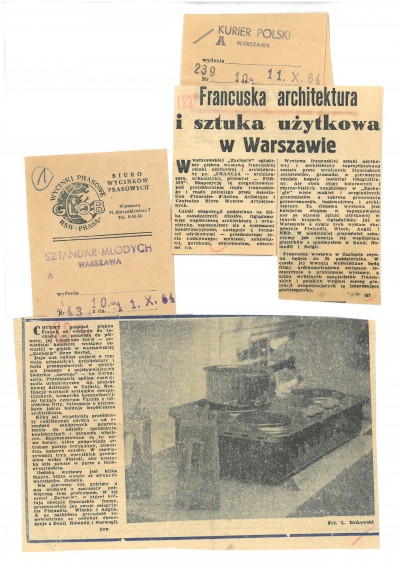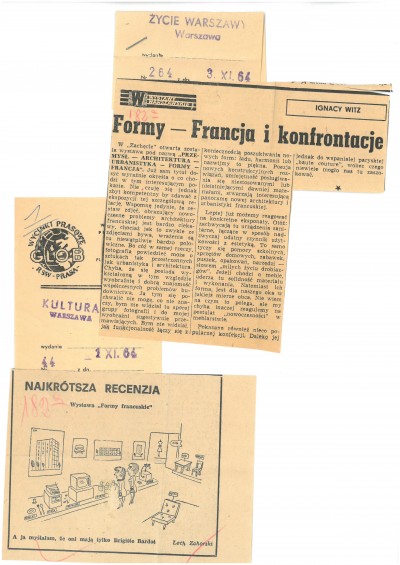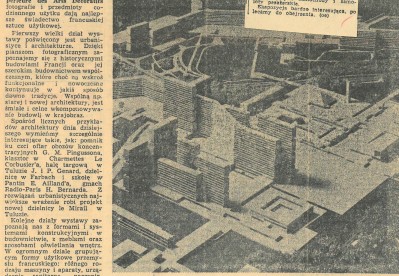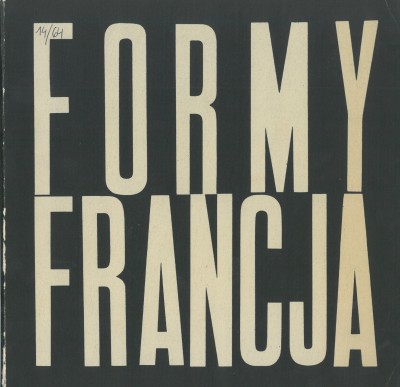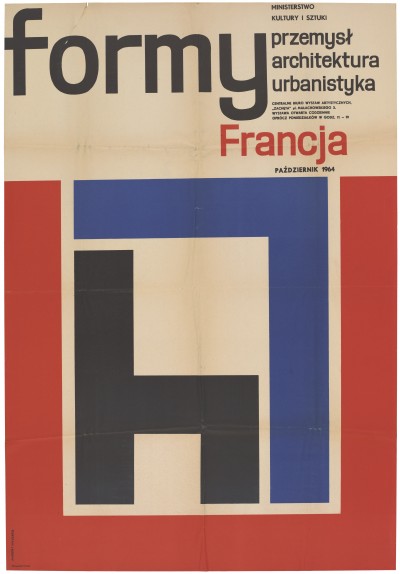Forms — France Industry, Architecture, Urban Planning
09.10 – 29.10.1964 Forms — France Industry, Architecture, Urban Planning
Zachęta Central Bureau of Art Exhibitions (CBWA)
organiser: Association Française d’Action Artistique, Central Bureau of Art Exhibitions under the auspices of the French and Polish governments
commissioner: René Herbst
exhibition design: Jacques Famery
poster design: Hubert Hilscher
number of exhibits: 250
attendance: 17,083 (Rocznik CBWA [CBWA Annual])
The exhibition at Zachęta was a big show of contemporary French architecture and the applied arts. Since the second half of the 1950s, cultural exchange between France and Poland had gradually intensified, which manifested itself in state-supported exhibitions. The curator of Forms was a famous interior and furniture designer, René Herbst, a co-founder of the French Union of Modern Artists (L’Union des artistes modernes, UAM) established in 1929, and from 1950 to 1966, head of Formes utiles, a UAM section dedicated to industrial design. Jacques Famery, then a budding designer, was in charge of the arrangement of the Warsaw exhibition.
Two halls hosted the Architecture and Urban Planning and Structural Systems sections, encompassing over 90 photographs and several models of the objects selected by Max Blumenthal, an architect and experienced editor-in-chief of the prestigious periodical Techniques et architecture. The idea behind this part of the display was to contrast photographs of the French countryside and monuments, hanging close to the entrance, with the main material related to public utility and housing construction from the mid-1950s onwards. The latter was especially brought to the fore by numerous illustrations in the catalogue, which also emphasised the thread of commemorating the victims of the Second World War (the publication opened with three reproductions of the only memorial at the exhibition — the Paris Mémorial des Martyrs de la Déportation [NB: described as a ‘monument in honour of the victims of the concentration camps’] designed by Georges-Henri Pingusson).
As René Herbst indicates in the introduction to the exhibition catalogue, ‘After the beginning, imbued with tranquillity, we pass through to great undertakings and radical transformations, to urban planning which, without changing the character of the landscape, enriches it with modernity which addresses the needs of today’s life.’[1] The contemporary exhibition strove to outline France’s architectural landscape right in the middle of Trente Glorieuses: apart from the aesthetics giving prominence to sophisticated structures, the trend of modernism, with the designer’s strong and expressive visual gesture (Émile Aillaud, Le Corbusier), could be discerned.
What drew the viewer’s attention was the fact that not only architects were treated as subjects of that part of the show, but also institutional protagonists of the industrialisation of France at that time: central offices, huge state-owned concerns and private building companies. The demonstration of their technological innovativeness had obvious mercenary overtones — in the 1950s and 1960s French systems of industrialised building constituted important export products, interesting also for the Eastern Bloc countries.
The next sections of the exhibition dealt with the issues of interior and industrial design. The objects on display were selected by accomplished exhibition designers and artists. Antoine Philippon and Jacqueline Lecoq, recognised furniture designers following the UAM traditions, chose almost forty exhibits for the Furniture — Textiles — Lighting section. The section Functional Forms comprised 70 items picked by Paul Bréton and Hervé de Looze, deputy presidents of Formes utiles and also connected with the prestigious annual Salon des arts ménagers. There were almost forty pieces of popular clothing in last part of the exhibition, Man — Woman — Child, prepared by Anne Marie Cheret from the L’École nationale supérieure des Arts Décoratifs (NB: not a single iconography of this exhibition survived, and its perfunctory character was mentioned in few reviews).
The entirety corresponded well with the opinion of Michel Faré, an art historian and chief conservator of Musée des Arts Décoratifs, published in the catalogue: ‘Technological progress provides the artist with solutions unknown hitherto, while an ever greater mechanisation, to which he submits himself so readily, simultaneously gives all of us a chance to facilitate our everyday life. The artist is thus a creator of a new humanism, one which determines the shape and function of objects from our immediate surroundings.’[2]
The works of Charles Chaynes provided the musical setting of the exhibition, while the accompanying lectures were given by painter Jacques Fillacier (Colour, Field of Vision, Societies), architect Jean Prouvé (Effects of Industrialisation of Flats) and the interior designer Jacques Dumond (Genuine Tradition: Industrial Aesthetics Is Transforming the Applied Arts).
On the whole, Polish critics received the event favourably, perceiving it as a continuation of the cycle of the national reviews of applied arts (Finland, Italy and England were hinted at). The most astute critics noticed the ideological assumptions of the exhibition: ‘The French truly care about underscoring the continuity of the tradition, showing that what is happening now logically results from the past, that today’s France is an artistic power just as it was in the era of the Gothic cathedrals. In it, you can hear a reply to the accusations of “Americanisation” and an imitative nature.’[3]
Aleksy Czerwiński also highlighted the main thesis that ‘the nature of humans’ artistic work, through which they shape their environment according to the current needs of life, owes to the conditions of the country, its climate and landscape’, and this leads to ‘a uniform method of visual thinking discernible in various practical functions and even in different epochs.’[4]
Consequently, the exhibition organisers managed to communicate a clear and unambiguous message to the Polish viewer, embodying the principles of Gaullism. Nowadays, the critics’ statements about various parts of the show can largely be regarded as an attempt to evaluate the Polish achievements in a given area after the Thaw (and it should be remembered that trips to France had been, for the younger generation, one of the initiating experiences in assimilating modernity since 1956). While critics felt quite unanimously content with bridging the gap between Polish and French creators (the latter being erstwhile masters) in the field of architecture and urban planning, the section devoted to design provoked such remarks as ‘there is a lot to see here. And a lot to envy as well’, in particular as far as goods commonly offered on the market were concerned. The voice of Jerzy Lessman, who noticed ‘a pretty bad image of French industrial production’,[5] remained an isolated case.
The exhibition clearly stressed the distance between the two countries in respect of everyday comfort of living, which was one of the main themes at international presentations of the applied arts in the 1960s.
Marek Czapelski
Institute of Art History of the University of Warsaw
This compilation was prepared as part of the National Programme for the Development of Humanities of the Polish Minister of Science and Higher Education — research project The History of Exhibitions at Zachęta — Central Bureau of Art Exhibitions in 1949–1970 (no. 0086/NPRH3/H11/82/2016) conducted by the Institute of Art History of the University of Warsaw in collaboration with Zachęta — National Gallery of Art.
Bibliography
Catalogues:
- Matusińska, Maria, ed. Formy Francja. Przemysł, architektura, urbanistyka, Warsaw: Centralne Biuro Wystaw Artystycznych, 1964
- Hackiewiczowa, Wanda, Maria Matusińska, Barbara Mitschein, Ada Potocka, Halina Zacharewicz, eds. Rocznik CBWA 1963–1964, Warsaw: Centralne Biuro Wystaw Artystycznych, [1965], pp. 61–62
Source texts:
- Czerwiński, Aleksy. ‘Propozycje francuskiego wzornictwa’. Stolica, no. 45, 8 November 1964
- Delaporte, Guillemette. René Herbst, pionnier du mouvement moderne. Paris, 2004
- ‘Formy’. Kultura, no. 43, 25 October 1964
- (g). ‘Francuska architektura i sztuka użytkowa w Warszawie’. Kurier Polski, no. 239, 11 October 1964
- hen. ‘Chcemy pokazać piękno Francji . . .’. Sztandar Młodych, no. 243, 1964
- Lessmann, Jerzy. ‘Rozczarowanie wzornictwem francuskim.’ Express Ilustrowany, no. 251, 1964
- (oe). ‘Francuskie meble i przedmioty codziennego użytku w „Zachęcie”’. Dziennik Ludowy, no. 241, 1964
- (szem). ‘Francuskie wzornictwo na wystawie w „Zachęcie”’. Gazeta Handlowa, no. 83, 16 October 1964
- Wieluński, Lech. ‘Piękne przedmioty znad Sekwany’. Głos Pracy, no. 244, 13 October 1964
- Weiss, Jerzy. ‘Urbanistyka we Francji’. Słowo Powszechne, no. 244, 10–11 October 1964
- Witz, Ignacy. ‘Formy — Francja i konfrontacje’. Życie Warszawy, no. 264, 3 November 1964
- ‘W Zachęcie wystawa Formy — Francja’. Współczesność, no. 173, 28 October– 11 November 1964
- (ZS). ‘Wystawy architektury zagranicznej’. Tygodnik Demokratyczny, no. 43, 1964
- (ż). ‘Francuska architektura, urbanistyka . . .’. Trybuna Ludu, no. 274, 1964
- ŻM EL. ‘Formy Francja’. Zwierciadło, no. 43, 25 October 1964
Artists:
Urban Planning and Architecture:
Émile Aillaud, Edouard Albert, Alain Champetier de Ribes, Michel Andrault, Pierre Parat, Roger Anger, Pierre Puccinelli, André Aubert, Pierre Bonin, Robert Auzelle, Jacques Fillacier (painter), Daniel Badani, Pierre Roux-Dorlut, Abro Kanjian, François Balp, Eugène Beaudoin, Michel and Jean-Pierre Béguin, Henry Bernard, Berthe-Chappis-Joumain, Alain Bourbonnais, Roger Boileau, Jacques Henri-Labourdette, Paul Bossard, Georges Bovet, Emile Berthelot, Robert Cuzol, André Bruyère, Jacques-Henri Calsat, Charles Berthelot, Robert Camelot, Jean de Mailly, Bernard Zehrfuss, Georges Candilis, Paul Dony, Alexis Josic, Shadrach Woods, René-André Coulon, Yves Magnant, Ionel Schein, Jean Maneval, Philippe Douillet, Jean Demaret, Pierre Dufau, Jean Dubuisson, René Egger, Michel Fourtané, Joachim and Pierre Génard, Gillaume Gillet, Jean Ginsberg, André Gomis, Vladimir Bodiansky, Gérard Grandval, Jean-Raphaël Hébrard, R. Ledieu, Jean Percillier, Paul Herbé, Jean Le Couteur, Guy Lagneau, Michel Weill, Jean Dimitrijevic, Paul La Mache, Gaston Leclaire, Le Corbusier, André Lefèvre, Jean Aubert, Jean-Michel Legrand, Marcel Lods, André Malizard, Jean-Jacques Honegger, Jacques Beufé, Raymond Lopez, Raymond Gravereaux, Henri-Pierre Maillard, Paul Ducamp, Jean de Mailly, Lucien Metrich, Anatole Kopp, René Sarger, Daniel Mikol, Gérald Brown-Sarda, Jean Monge, Maurice Novarina, Jean Prouvé, C. Ouvaroff, Auguste Perret, Jean Perrottet, Jacques Kalisz, Georges-Henri Pingusson, Guy Pison, R. Burkat, Henri Pottier, Jean Tessier, Pierre Puccinelli, Yves Salier, Alexandre Courtois, Charles Sebillotte, André Sive, Pierre Forestier, Pierre Sonrel, Jacques Thual (decorator), Olivier Vaudou, Henri Vicariot
Charbonnages de France, Electricité de France, Gaz de France, Ministère de la construction, Ministère des travaux publics des transportes et du tourisme, Saint Gobain, Touring club de France, Usinor
Structural Systems:
Balency et Schuhl, Chaneac, Coignet, Compagnie Française d’Entreprises, Consortium d’Entreprise de Travaux, Costamagna, Stéphane du Château, Estiot et Cie, Tracoba
Furniture — Lightning:
(In the subsequent sections, the exhibitor companies and the names of the designers of the objects presented by these companies, if known, have been listed together. In several cases, designers who ran the companies were also the exhibitors.
Airborne (design by Pierre Guariche, Antoine Philippon, Jacqueline Lecoq, Etienne Fermigier), Apes – Agence Parisienne d’Esthétique Industrielle (design by Roger Fatus), Artifort (design by Pierre Paulin), Bartolini (design by Antoin Philippon), Charron (design by Joseph-André Motte), J. Degoree et Cie (design by Antoine Philippon and Jacqueline Lecoq), Disderot Atelier (design by Etienne Fermigier, Pierre Paulin, Jacques Dumond, Pierre Gautier-Delaye, Pierre Guariche, René-Jean Caillette, Joseph-André Motte), Jacques Dumond et Philippe Leloup (designers), Luminalite (design by Jacques Biny), E. H. Martin (designer), Minvielle Ets (design by A.R.P. [Atelier de Recherches Plastiques], Antoine Philippon i Jacqueline Lecoq), Polytechnique du Siege Steiner (design by Joseph-André Motte, René-Jean Caillette), Roset Ets, Sentou (design by Roger Tallon), Societe Industrielle du Rotin (design by Janine Abraham and Dirk Jan Rol), T.V. (design by André Monpoix, Alain Richard), Vergneres Ets (design by Pierre Gautier-Delaye)
Textiles:
Geneviève Dupeaux, Jacqueline Iribe, Placide Joliet, Brunet Lecomte Ets, Carlos Lepetre Ets, Mobilier National (design by Gustave Singier, Le Corbusier, Jean Arp)
Functional Forms:
Adam et Mercier (design by Philippe Charbonneaux), l’Alluminium Ménager (design by J. Firdmann), Applimo, Ateliers Reunis S.A., Ateliers de Saint Leonard A.S.L (design by Compagnie d’Esthétique Industrielle), Aubeco – Auxi S.A., Bioplastic (design by Pierre Giraudon), Bretton Ets (design by Jean Parthenay), Briche, Brot Miroiterie, Bull Cie des Machines (design by Tiarko Meunier, Philippe Charbonneaux), Calor Ets, Chappe Frères et Gessalin, Charpentier, Citroën, Clarville C.S.F., Coder Ets, Compagnie Française d'Entreprise (C.F.E), Compagne des Lamps, Controlec-Paris (design by L. Hirbec), Cosson S.A.R.L, Le Creuset S.A.R.L (design by Schmitt), Dubigeon — Normandie (design by Jacques André), Dyna Ets (design by Michel Vioche), Equipinox, Fabrique d’appareillage electrique de la cie générale d’electricité (design by Technes), Facom Société (design by Renan de la Godelinais), Frigeavia Société Française (design by Technes), Grosfillex Ets, Guilliet, Harmand Cuisines, Holophane Société, Japy Ste de mécanographie (design by Technes), Jaz S.A. (design by Philippe Charbonneaux), Lafuma Frères B.P.No I, J. Luce (designer), Markhbein S.A. (design by Jacques Dumond), Matériel de voirie LE, Merlin et Gerrin, Mingori S.A.R.L, Mondiale (design by Technes), Morisseau Ets (design by J. Morisseau), Moulinex, Neophone (design by Contraste), Nicoll S.A., Ougen Ets (design by Michel Vioche), Panhard Ets, Pautry Ets (design by P. Pautry), Philips S.A. (design by J. Goudeman, A. Clarisse), Photosia (design by Michel Vioche), Plastimonde S.A., Poclain Ets, Porcelaine de Paris (design by Jacques Dumond and Philippe Leloup), Prisunic (design by Bureau du Style Prisunic), Gueroy S.A., Quo Vadis Editions (design by Beltrami), Renault, Forges et Aciéries du Saut du Tarn (design by Deville), Société SCAAL (design by Etienne Fermigier), Schneider — Westinghouse (design by Michel Vioche), Scholtes Ets, Simca, Société d’Electronique et d’Automatisme (S.E.A) (design by Michel Vioche), Société Générale de Fonderie (design by Compagnie d’Esthétique Industrielle, Pierre Gautier-Delaye), Société nationale des chemins de fer français, Sovirel Ets (design by Harold Barnett), Société nationale de constructions aéronautiques Sud-Aviation, Testut S.A., Thermor Cie (design by Tiarko Meunier), Thomson Houston Cie Française, Thuillier — Lefrant Ets (design by J. Goudeman), Ugine — Gueugnon, G. Tirlet (designer), R. Trubert (designer), Voluform S.F.A.M, Vynckier Frères Société Française (design by B.E. Vynckier)
Man — Woman — Child
Ciolek, Dejac, Jane Lend, Prenatal, S.P.A.S., Vaskene, White House
[1] René Herbst, ‘Wstęp’, in Formy Francja. Przemysł, architektura, urbanistyka, exh. cat., Warsaw: Centralne Biuro Wystaw Artystycznych, 1964, n.pag.
[2] Faré, ‘Wstęp’, ibid., n.pag.
[3] ŻM EL., ‘Formy Francja’, Zwierciadło, no. 43, 25 October 1964.
[4] Aleksy Czerwiński, ’Propozycje francuskiego wzornictwa’, Stolica, no. 45, 8 November 1964.
[5] Jerzy Lessmann, ‘Rozczarowanie wzornictwem francuskim’, Express Ilustrowany, no. 251, 1964
Forms — France
Industry, Architecture, Urban Planning
09.10 – 29.10.1964
Zachęta Central Bureau of Art Exhibitions (CBWA)
pl. Małachowskiego 3, 00-916 Warsaw
See on the map
